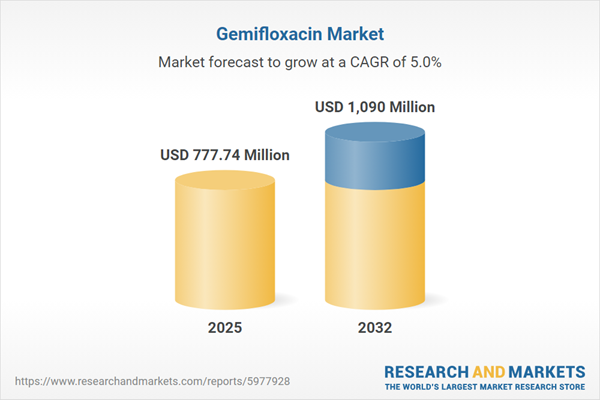Speak directly to the analyst to clarify any post sales queries you may have.
The Gemifloxacin market is experiencing a period of significant transformation as executive priorities shift toward advanced infection management strategies, compliance readiness, and resilient pharmaceutical supply chains. Senior decision-makers need clear insights to respond to these evolving industry pressures and maintain competitive positioning.
Market Snapshot: Gemifloxacin Market Size and Growth Trajectory
Valued at USD 741.01 million in 2024, the global Gemifloxacin market is projected to reach USD 777.74 million by 2025 and USD 1.09 billion by 2032. This upward trajectory demonstrates ongoing demand for effective antimicrobial therapies, particularly for conditions such as chronic bronchitis and community-acquired pneumonia. Healthcare organizations are strengthening their infection control and stewardship practices, driving broader utilization of Gemifloxacin. In response to shifting regulatory protocols, market participants are realigning workflows and operational strategies. These actions underpin new approaches to market growth and risk management across both mature and emerging regions.
Scope & Segmentation
This report is designed for executive leaders managing Gemifloxacin portfolios and procurement strategies, offering granular segmentation and actionable insights for investment and operational planning. Key analyzed areas include:
- Indication: Evaluation of demand for targeted antimicrobials addressing chronic bronchitis and community-acquired pneumonia, with emphasis on persistent antimicrobial resistance challenges.
- Distribution Channel: Assessment of hospital pharmacy networks, retail drug distributors, and digital platforms influencing availability and timely access to Gemifloxacin.
- End User: Analysis of adoption patterns among hospitals, clinics, and ambulatory surgical centers, including impacts from evolving care models and payer structures.
- Regional Coverage: Review of opportunity drivers and risk barriers across the Americas, Europe, Middle East & Africa, and Asia-Pacific, supporting tailored market entry and operational agility.
- Key Companies: Competitive analysis of key industry players such as Mylan N.V., Teva Pharmaceutical Industries Ltd, Sandoz International GmbH, Cipla Ltd, Lupin Ltd, Dr. Reddy’s Laboratories Ltd, Aurobindo Pharma Ltd, Sun Pharmaceutical Industries Ltd, Torrent Pharmaceuticals Ltd, and Cadila Healthcare Ltd, with focus on strategies and supply network development.
Regional insights assist organizations in adapting to local regulatory expectations, while technology advancements—such as precision diagnostics—facilitate more effective infection identification and targeted prescribing. Executive decision-makers benefit from understanding how procurement and logistics technology integration supports continuity of supply and mitigates compliance risks.
Key Takeaways for Senior Decision-Makers
- Gemifloxacin enables adaptive infection management strategies, supporting rapid organizational response to evolving treatment guidelines and antimicrobial resistance trends.
- Pharmacokinetic properties of Gemifloxacin promote integration into both inpatient and outpatient care, streamlining care transitions and resource management.
- Telehealth expansion and digital prescribing enhance accessibility to Gemifloxacin, particularly in regions where traditional healthcare delivery faces operational gaps.
- Process efficiencies in procurement allow for value-focused purchasing, sustained resource allocation, and compliance with regulatory standards even under pressure.
- Collaborations with diagnostic and technology firms enhance infection identification precision, improving treatment targeting and overall patient outcomes.
- Diversifying supplier relationships strengthens organizational resilience against policy shifts and regulatory change, ensuring operational continuity in uncertain environments.
Tariff Impact on Supply Chains and Sourcing Strategies
Adjustments in U.S. tariff policy are prompting organizations in the pharmaceutical sector to reconsider sourcing models and supply chain structures. Initiatives include supplier base diversification, procurement optimization, and logistics technology investment to maintain regulatory compliance. These efforts stabilize expenses and manage risks associated with geopolitical or policy shifts, ultimately supporting consistent and sustainable engagement in the Gemifloxacin market.
Methodology & Data Sources
Research is grounded in direct interviews with industry executives, procurement managers, and distribution experts. Findings are validated through peer-reviewed publications, regulatory filings, and established market datasets, ensuring information is both accurate and actionable for business leaders.
Why This Report Matters
- Empowers senior stakeholders to refine investment decisions and recalibrate strategic planning based on competitor approaches and emerging market risks.
- Offers guidance to strengthen operational processes and supply chains, safeguarding against technical, compliance, and regulatory disruptions.
- Clarifies the interplay among changing care models, payer environments, and growth avenues, enabling informed organizational planning and effective risk mitigation.
Conclusion
By leveraging the intelligence presented, decision-makers can effectively manage operational uncertainties, capture strategic opportunities, and guide their organizations toward sustained performance within the Gemifloxacin market.
Additional Product Information:
- Purchase of this report includes 1 year online access with quarterly updates.
- This report can be updated on request. Please contact our Customer Experience team using the Ask a Question widget on our website.
Table of Contents
3. Executive Summary
4. Market Overview
7. Cumulative Impact of Artificial Intelligence 2025
Companies Mentioned
The companies profiled in this Gemifloxacin market report include:- Mylan N.V.
- Teva Pharmaceutical Industries Ltd
- Sandoz International GmbH
- Cipla Ltd
- Lupin Ltd
- Dr. Reddy’s Laboratories Ltd
- Aurobindo Pharma Ltd
- Sun Pharmaceutical Industries Ltd
- Torrent Pharmaceuticals Ltd
- Cadila Healthcare Ltd
Table Information
| Report Attribute | Details |
|---|---|
| No. of Pages | 181 |
| Published | October 2025 |
| Forecast Period | 2025 - 2032 |
| Estimated Market Value ( USD | $ 777.74 Million |
| Forecasted Market Value ( USD | $ 1090 Million |
| Compound Annual Growth Rate | 4.9% |
| Regions Covered | Global |
| No. of Companies Mentioned | 11 |









